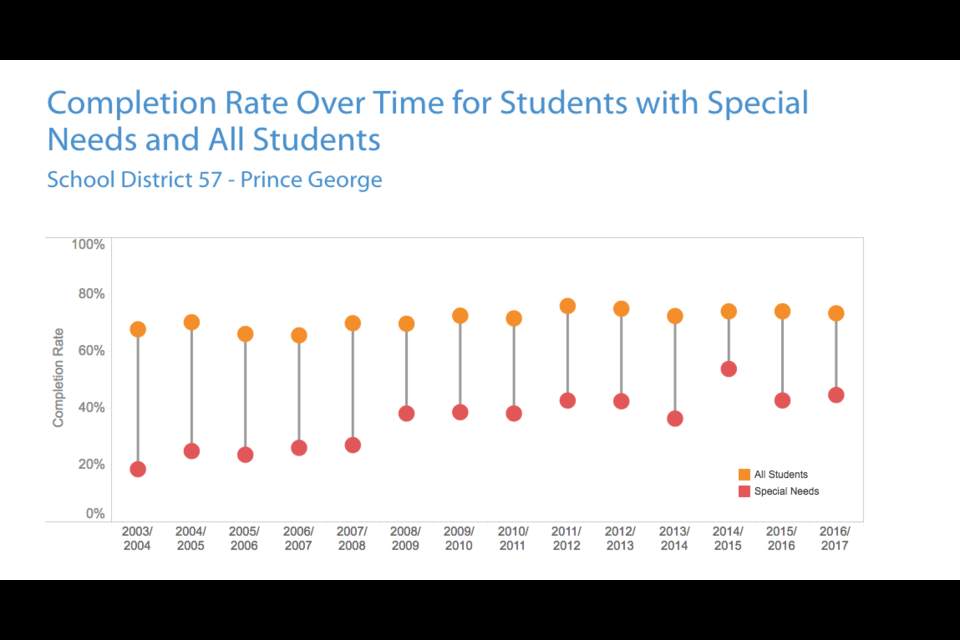School District No. 57 saw large increases in the high school completion rates for aboriginal and special needs students over the last 10 years, as well as modest improvements in overall graduation rates.
According to figures released by the B.C. Ministry of Education, over the last 10 years, aboriginal completion rates jumped from 39 per cent in 2006-2007 to 57 per cent last year. This represents an increase of 27 per cent. Over the same time period, the completion rates for special needs students jumped from 26 per cent to 44 per cent, an increase of 17 per cent.
The completion rate for all high school students in the district rose from 65 per cent in 2006-07 to 73 per cent in 2016-17.
The district's completion rates are all, however, lower than the provincial average. Across the province, the overall completion rate for high schools stands at 84 per cent, while the aboriginal completion rate is at 66 per cent. The provincial special needs completion rate, at 69 per cent, is 25 per cent higher than that of School District No. 57.
According to District 57 chair Tim Bennett, the improvements over the last ten years have been largely due to an emphasis on more personalized learning.
"High schools now are offering such a wide arrange of programming to focus on getting kids engaged," Bennett said.
Bennett said the district curriculum has focused more on individualized learning, tailored to students. This has resulted in more diverse course offerings.
"Showcase your learning how you want whether it's a traditional book report, whether it's making a music video, it's about showcasing that you understand the concept, not just regurgitating data," Bennett said.
"Seeing what has been able to be offered in these courses, I wish we had those types of options when I was a student."
Bennett graduated from D.P. Todd Secondary in 2004.
Andrew Kitchenham, chair of UNBC's school of education, said investment in the aboriginal education branch of the school district has made a significant difference in improving the education experience of the district's 3,249 aboriginal students.
"We are very fortunate that the aboriginal branch of the school board is massive, I think there are 100 people [working] there. So there is a lot of support for aboriginal students. In this particular school district, that is a major other prong as to why the rates have gone up," Kitchenham said.
Kitchenham said the province has incorporated more indigenous-oriented curriculums, and has also incorporated the First Peoples' Principles of Learning. These principles were the product of an initiative between the B.C. Ministry of Education and the First Nations Education Steering Committee, and were established in 2008.
All high schools in the district have on-site staff from the aboriginal education branch. Prince George Secondary School also has a First Nations learning centre.
"We have learned to have safe places for aboriginal students so that they know it is not as scary for them to be in school so they stay longer," Kitchenham said.
Kitchenham said the focus on personalized education has also played a role in the improved completion rates for special needs students.
According to Marilyn Marquis-Forster, superintendent of schools for District 57, the region has traditionally had lower high school graduation rates across the board, partly because of the presence of resource and forestry sectors within the region.
"Lots of students in past years have been able to exit, perhaps without graduating, and move into some pretty high paying, good quality jobs," Marquis-Forster said.
Still, Marquis-Forster said the district has a long way to go to reduce the discrepancy between aboriginal and non-aboriginal students. She said the district's strategic plan, adopted in April of last year, has a goal of meeting or exceeding the provincial graduation rates for both aboriginal and non-aboriginal students.
"We still, as a province, do have a discrepancy between our indigenous and non-indigenous students. That continues to be something we want to do better with, as a province and certainly as a district," she said.
"We're very proud of that. We're absolutely not yet satisfied."



